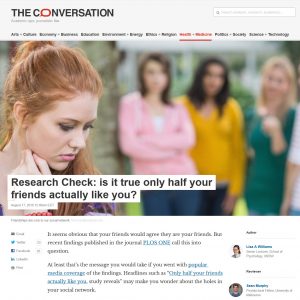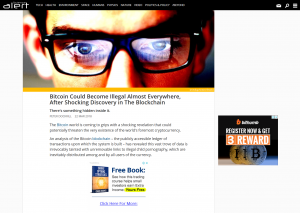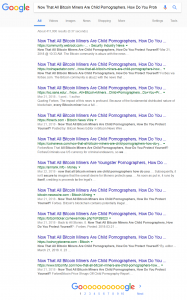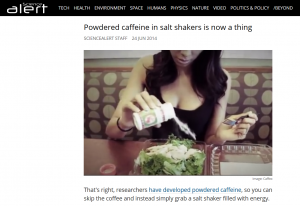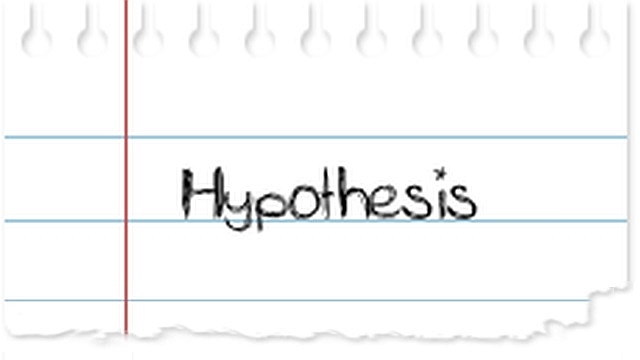![Social Media Board Structure Networking [Pixabay image 1157114]](https://realkm.com/wp-content/uploads/2018/05/social-1157114_640.jpg)
Be cautious with the “science” in science news feeds on social media
Pew Research Center recently published the findings of a systematic analysis of six months’ worth of posts from 30 of the most followed science-related pages on Facebook. These pages comprised 15 Facebook accounts from “multiplatform” organizations, for example National Geographic and the Discovery Channel, and 15 accounts from individuals or organizations that have a large social media presence on Facebook but are not connected to any offline, legacy outlet.
As the above infographic from the analysis shows,
Millions of people see science-related information on their Facebook feeds or elsewhere on social media, but the kinds of science stories people most likely encounter are often practical tips with “news you can use” or promotions for programs and events rather than new developments in the science, engineering and technology world.
The researchers who published the analysis also state that:
The set of 30 covers a broad range of pages available to social media users, including several that are widely seen in the scientific community as offering questionable or even “pseudoscientific” advice or information.
One of the 30 that has given me cause for concern in regard to questionable information is ScienceAlert. The four ScienceAlert article examples that follow clearly illustrate the reasons for this concern.
Examples of questionable science in ScienceAlert
It’s possible to live a normal life without 90 percent of your brain (13 July 2016)
The first example is one we’ve already exposed.
Writing in the NeuroLogicaBlog, Dr. Steven Novella had raised significant concerns in regard to one of the ScienceAlert 23 science facts that emerged in 2016: that it’s possible to live a normal life without 90 percent of your brain. Novella had described the Science Alert article as “an excellent example of horrible science news reporting”, and “a cautionary tale of what can happen when a reporter does not adequately vet their story with actual experts.”
The article has since been updated, but should never have been published with its original incorrect and misleading headline and text.
Only Half of Your Friends Actually Like You, Science Reveals (1 May 2018)

The second example comes from the beginning of this month, and relates to a 2016 study1 looking at friendship.
The “Only Half of Your Friends Actually Like You” headline immediately a caught my eye when I saw it in my Facebook news feed. This is because that headline and reporting approach was criticised for being sensationalistic in a Research Check published in The Conversation in 2016. I republished the Research Check in RealKM Magazine at the time because it highlights a clear example of the hyping of science reporting.
The author of the Research Check, social psychologist Dr Lisa A Williams, advises that while the research in question offers some useful insights into the nuances of how friendship is perceived, it does not in fact speak to whether half of your friends like you.
Further, postdoctoral fellow Sean Murphy, who peer-reviewed the Research Check, states that:
My biggest problem with this paper … is the sensationalised interpretation of the results. The study abstract claims “people are typically poor at perceiving the direction of their friendship ties”, and media reports state that “only half of your friends like you”.
But the data support a humbler, and perhaps happier, story. In fact, when participants claimed someone as a friend, the other person reciprocated 70% of the time. So while it’s true around half of the friendships in the study were mutual, it still found close to three-quarters of your friends “like you”.
The second paragraph of the Research Check links to an example of the sensationalistic headlines, which turns out to be an earlier version of the 1 May 2018 ScienceAlert article.
So, despite having had the opportunity to change the headline to something more appropriate when they updated the article, ScienceAlert has chosen to ignore the Research Check and stick with the same incorrect and sensationalistic “Only Half of Your Friends Actually Like You” attention-grabbing headline.
Bitcoin Could Become Illegal Almost Everywhere, After Shocking Discovery in The Blockchain (22 March 2018)
The third example was published in March this year, and relates to a new study2 analysing the impact of arbitrary blockchain content on bitcoin.
The introductory paragraphs of the ScienceAlert article state that:
The Bitcoin world is coming to grips with a shocking revelation that could potentially threaten the very existence of the world’s foremost cryptocurrency.
An analysis of the Bitcoin blockchain – the publicly accessible ledger of transactions upon which the system is built – has revealed this vast trove of data is irrevocably tainted with unremovable links to illegal child pornography, which are inevitably distributed among and by all users of the currency.
However, in a news post on Bitcoin.com, Kai Sedgwick takes this assessment to task:
The [child pornography] on the blockchain story isn’t news and it isn’t new either. In fact, it was first dragged up in 2013, and has been revived, six years on, purely because a new paper has given the claims an air of legitimacy. News outlets were quick to jump on the story again, which was then widely shared by attention trolls … The false hypothesis comes from the fact that it’s possible to encode information in the blockchain.
Drawing on a recent paper3 which looked at data insertion in the Bitcoin blockchain, Sedgwick goes on to explain that anyone inspecting the blockchain won’t find words, rather a hex code (which he says looks for example like 000000000019d6689c085ae165831e934ff763ae46a2a6c172b3f1b60a8ce26), and that the option used to encode the child pornography information on the blockchain, called OP_RETURN, is limited to only 80 bytes in size and subject to deletion for efficiency.
Because of this, Sedgwick states that:
Anyone wishing to use the bitcoin blockchain to seek out child pornography [CP] would need to perform the following convoluted process:
Download the entire bitcoin blockchain and sift through 251 million transactions to find the 1.4% that contain some kind of arbitrary data encoded in them.
Ensure that the version of the blockchain you were using had been subject to no pruning that might have removed OP_RETURN data.
Extract any web links that might be concealed in the data using some sort of steganography.
Type the links into your browser until you eventually found a website that was still accessible.
To assert that the bitcoin blockchain contains child pornography is disingenuous, and is no more meaningful than saying that the internet contains CP. You could live to 100 and never encounter CP on the web, because that’s not how the web works. And that’s not how the blockchain works either.
This assessment is quite different to the impression given by the ScienceAlert article and headline.
In regard to the media claims that the child pornography revelations threaten the very existence of Bitcoin, Sedgwick adds the following comment in regard to responsibility:
Asserting that there is child pornography on the blockchain would be like strolling through the U.S. Capitol Building, dropping a scrap of paper containing a deep web address, and then claiming that the American government is storing obscene content.
The ScienceAlert article is however quite some way from what appears to be the worst case of what Sedgwick describes as “attention trolling” in regard to the Bitcoin child pornography story. I would award this dubious honor to Forbes for the extraordinary headline “Now That All Bitcoin Miners Are Child Pornographers, How Do You Protect Yourself?”.
This Forbes article has apparently since been taken down (very likely at the request of lawyers) but not before being parroted by numerous other sites, as a Google search of the headline shows. This illustrates how incorrect or hyped information can be widely circulated.
(If you’d like to read some evidence-based information on cryptocurrencies, of which Bitcoin is one of hundreds, then I suggest Izabella Kaminska and Martin Walker’s submission to the UK House of Commons Treasury Committee – Digital Currencies Inquiry.)
Powdered caffeine in salt shakers is now a thing (24 June 2014)
The fourth (but I’m not going to say “and final”) example I’ll put forward was published in 2014.
With no link to any credible research, this article aligns with the “news you can use” category identified in the Pew Research Center analysis (although I’m not sure how many people would really want to use a powdered caffeine product).
But that’s just the beginning of the problems with this article. A news post on the STEM (Science, Technology, Engineering and Mathematics) Women website identifies that “ScienceAlert’s scientific content is sorely lacking” in the article, and then goes on to detail two further serious issues:
The second issue is that the article uses sexism to masquerade as science. We don’t see the product. What we get instead is a generic stock image of a woman’s chest as she’s sprinkling a white substance over her food. Why this photo? Well, for one it was published as part of the press release on Caffex, the company that makes this product. But that’s no excuse for a science site; and here’s why. The woman’s face is cut out of the photo. She is not a whole woman; she is a sexualised marketing gimmick – one that we are unfortunately all too familiar with and sadly one that is starting to crop up in science publications. …
The third issue is about science moderation of sexist comments in a science context. ScienceAlert promotes itself as a science news site that collates sciences news from universities and think tanks. Evidently it will also publish press releases by companies regardless of the scientific rigour behind a product. ScienceAlert has failed to describe the possible physiological side effects of this product, and the scientific method behind the product or even the science credentials of the company. Heck, it listed three ingredients and didn’t bother to inform readers anything about their scientific significance. At the very least, the article might have drawn on the plethora of scientific research that addresses the potential benefits and side-effects of caffeine.
ScienceAlert promotes itself as a social media news site, specifically on Facebook, but it has failed to address the science questions about this story on its Facebook page. The site has almost 5.5 million Facebook followers. One of the ScienceAlert founders and Managing Director, Chris Cassella, who describes himself on his Twitter as an “Ex-Microsoft programmer & failed neuroscientist turned professional science enthusiast,” notes that he specifically promotes, “Facebook as a platform to inspire and engage young people around the world with science.” Given that this particular story has garnered over 1,800 likes, almost 700 shares and hundreds of comments, it is odd that ScienceAlert has not jumped in to answer any of the questions or comments, even though their followers are debating both the safety of this product and the scientific validity of the story.
The STEM Women website post reviews and discusses a range of these comments, and I encourage you to read their post in its entirety.
How to fix this problem?
As I’ve previously argued, Facebook and other social media and new media providers need to put in place stronger and more effective controls over the content they allow on their platforms.
But, as I’ve also previously argued, all of us also have to take responsibility for the choices we make as social media and new media consumers. To do this, we can all become metaliterate.
For me, ScienceAlert is the only science news feed that I follow on Facebook, and I follow it for insights into science communication (to help write articles like this), rather than for any “science” that they might actually present. For science news, I subscribe to The Conversation, and do my own research. I also actively seek to make evidence-based decisions.
Header image source: Image 1157114 by geralt on Pixabay is in the Public Domain.
References:
- Almaatouq, A., Radaelli, L., Pentland, A., & Shmueli, E. (2016). Are you your friends’ friend? Poor perception of friendship ties limits the ability to promote behavioral change. PloS one, 11(3), e0151588. ↩
- Matzutt, R., Hiller, J., Henze, M., Ziegeldorf, J. H., Müllmann, D., Hohlfeld, O., & Wehrle, K. (2018). A Quantitative Analysis of the Impact of Arbitrary Blockchain Content on Bitcoin. In Proceedings of the 22nd International Conference on Financial Cryptography and Data Security (FC). Springer. ↩
- Sward, A., Vecna, I., & Stonedahl, F. (2018). Data Insertion in Bitcoin’s Blockchain. Ledger, 3. ↩
Also published on Medium.


